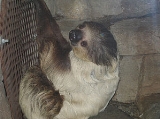
Atlantogenata
Encyclopedia
Atlantogenata is a proposed clade
of mammal
s containing the cohorts or super-orders Afrotheria
, Xenarthra
and Meridiungulata
. These groups originated and radiated in the South America
n and Africa
n continents, presumably in the Cretaceous
. Together with Boreoeutheria
it makes up Eutheria
. The monophyly
of this grouping was supported by some genetic evidence.
Alternative hypotheses are that Boreoeutheria and Afrotheria combine to form Epitheria
(as generally supported by anatomical and other physiological evidence) or that Boreoeutheria and Xenarthra combine to form Exafroplacentalia
or Notolegia.
Updated analysis of transposable element insertions around the time of divergence strongly support the fourth hypothesis of a near-concomitant origin (trifurcation) of the three superorders of mammals.
Clade
A clade is a group consisting of a species and all its descendants. In the terms of biological systematics, a clade is a single "branch" on the "tree of life". The idea that such a "natural group" of organisms should be grouped together and given a taxonomic name is central to biological...
of mammal
Mammal
Mammals are members of a class of air-breathing vertebrate animals characterised by the possession of endothermy, hair, three middle ear bones, and mammary glands functional in mothers with young...
s containing the cohorts or super-orders Afrotheria
Afrotheria
Afrotheria is a clade of mammals, the living members of which belong to groups from Africa or of African origin: golden moles, sengis , tenrecs, aardvarks, hyraxes, elephants and sea cows. The common ancestry of these animals was not recognized until the late 1990s...
, Xenarthra
Xenarthra
The superorder Xenarthra is a group of placental mammals , existent today only in the Americas and represented by anteaters, tree sloths, and armadillos. The origins of the order can be traced back as far as the Paleogene in South America...
and Meridiungulata
Meridiungulata
Meridiungulata is an extinct clade with the rank of cohort or super-order, containing the South-American ungulates: Pyrotheria , Astrapotheria, Notoungulata and Litopterna...
. These groups originated and radiated in the South America
South America
South America is a continent situated in the Western Hemisphere, mostly in the Southern Hemisphere, with a relatively small portion in the Northern Hemisphere. The continent is also considered a subcontinent of the Americas. It is bordered on the west by the Pacific Ocean and on the north and east...
n and Africa
Africa
Africa is the world's second largest and second most populous continent, after Asia. At about 30.2 million km² including adjacent islands, it covers 6% of the Earth's total surface area and 20.4% of the total land area...
n continents, presumably in the Cretaceous
Cretaceous
The Cretaceous , derived from the Latin "creta" , usually abbreviated K for its German translation Kreide , is a geologic period and system from circa to million years ago. In the geologic timescale, the Cretaceous follows the Jurassic period and is followed by the Paleogene period of the...
. Together with Boreoeutheria
Boreoeutheria
Boreoeutheria is a clade of placental mammals that is composed of the sister taxa Laurasiatheria and Euarchontoglires...
it makes up Eutheria
Eutheria
Eutheria is a group of mammals consisting of placental mammals plus all extinct mammals that are more closely related to living placentals than to living marsupials . They are distinguished from noneutherians by various features of the feet, ankles, jaws and teeth...
. The monophyly
Monophyly
In common cladistic usage, a monophyletic group is a taxon which forms a clade, meaning that it contains all the descendants of the possibly hypothetical closest common ancestor of the members of the group. The term is synonymous with the uncommon term holophyly...
of this grouping was supported by some genetic evidence.
Alternative hypotheses are that Boreoeutheria and Afrotheria combine to form Epitheria
Epitheria
Epitherians comprise all the placental mammals except the Xenarthra. They are primarily characterized by having a stirrup-shaped stapes in the middle ear, which allows for passage of a blood vessel. This is in contrast to the column-shaped stapes found in marsupials, monotremes, and xenarthrans...
(as generally supported by anatomical and other physiological evidence) or that Boreoeutheria and Xenarthra combine to form Exafroplacentalia
Exafroplacentalia
Exafroplacentalia or Notolegia is a subcohort selected in 2001 on the basis of molecular researches.-Exafroplacentalia:Exafroplacentalia places Xenarthra as a sister group to the magnorder Boreoeutheria , thus making Afrotheria a primitive group of placental mammals...
or Notolegia.
Updated analysis of transposable element insertions around the time of divergence strongly support the fourth hypothesis of a near-concomitant origin (trifurcation) of the three superorders of mammals.
External links
- Waddell PJ, Kishino H, Ota R. 2001. A phylogenetic foundation for comparative mammalian genomics. Genome Inform Ser Workshop Genome Inform 12: 141–154
- Mark S. Springer, William J. Murphy, Eduardo Eizirik, and Stephen J. O'Brien (Edited by Morris Goodman). 2002 Placental mammal diversification and the Cretaceous-Tertiary boundary
- Wildman D.E.; Chen C.; Erez O.; Grossman L.I.; Goodman M.; Romero R. 2006. Evolution of the mammalian placenta revealed by phylogenetic analysis. PNAS 103 (9): 3203–3208
- Nikolaev, S., Montoya-Burgos, J.I., Margulies, E.H., Rougemont, J., Nyffeler, B., Antonarakis, S.E. 2007. Early history of mammals is elucidated with the ENCODE multiple species sequencing data. PLoS Genet. 3:e2, doi:10.1371/journal.pgen.0030002.

